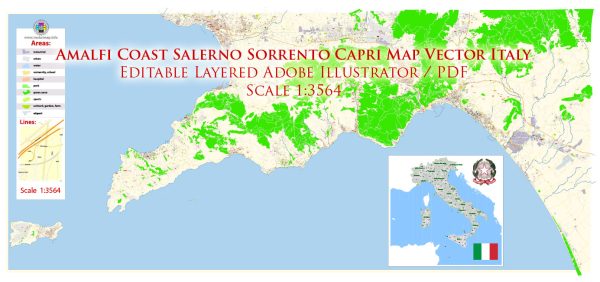The Amalfi Coast, situated in Southern Italy, is renowned for its stunning natural beauty, picturesque towns, and historical significance. The towns of Amalfi, Positano, Sorrento, and Salerno, among others, have a rich history of urban development that has shaped the region’s character.
- Amalfi:
- Amalfi was a prominent maritime republic in the Middle Ages, known for its trading prowess and naval power. The town’s history dates back to the Roman era, and its urban development was influenced by both Roman and Byzantine architecture.
- The Duomo di Sant’Andrea (Amalfi Cathedral) is a prime example of this historical influence, with its mix of Arab-Norman, Romanesque, and Byzantine elements.
- Amalfi’s urban layout features narrow, winding streets, steep staircases, and whitewashed buildings clinging to the cliffs, reflecting its medieval past.
- Positano:
- Positano is a picturesque town with a history dating back to the Roman era. It was a crucial part of the Amalfi Republic, and its development was influenced by the maritime trade routes.
- The town’s colorful, terraced buildings, nestled on the cliffs, give it a unique charm and are a product of its historical urban development.
- The Chiesa di Santa Maria Assunta, with its distinct dome, is a notable architectural landmark in Positano.
- Sorrento:
- Sorrento has a history that goes back to the Roman times when it was a popular resort for the Roman elite. Its urban development is a blend of ancient Roman and medieval influences.
- The town’s historic center is characterized by narrow streets, charming squares, and palazzi (palaces) with courtyards. The Cathedral of Sorrento and the Vallone dei Mulini are key historical landmarks.
- Salerno:
- Salerno is the largest city on the Amalfi Coast and has a history that dates back to Roman times. It was an important center for learning and culture during the Middle Ages.
- The city’s urban development is a mixture of Roman, medieval, and more recent architectural influences. The Salerno Cathedral and the Arechi Castle are prominent historical sites.
- Salerno played a significant role in the medical field, and the Schola Medica Salernitana, a medieval medical school, was a testament to its intellectual contributions.
Throughout the region, urban development has been closely tied to the challenging topography of the Amalfi Coast, with towns perched on cliffs and hillsides, offering breathtaking views of the Tyrrhenian Sea. The history of the Amalfi Coast’s urban development reflects the influence of various cultures, including Roman, Byzantine, Arab-Norman, and medieval Italian, resulting in a unique and captivating blend of architecture and culture that continues to draw visitors from around the world.


 Author: Kirill Shrayber, Ph.D.
Author: Kirill Shrayber, Ph.D.